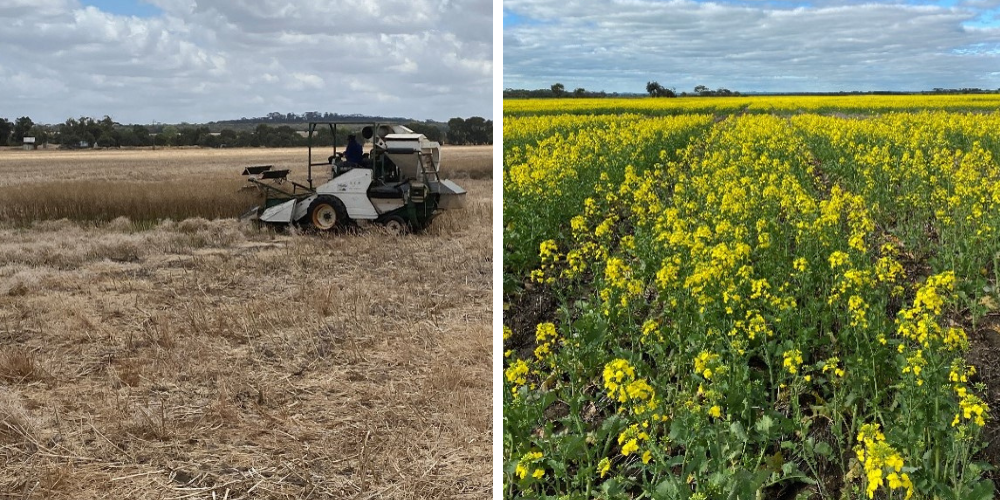Canola establishment – is it improved through the application of wetters to the seed in marginal conditions?
2020-4 Facey Group

Overall Objective
1) To investigate the use of wetting agents, applied directly to canola seed to understand the impact it has on crop establishment and end of season yield in water repellent soils. The aim is to investigate an alternative application method to the current furrow and banded treatment of wetters; for ease of management directly coating the seed. The project will intend to find an alternative use option for wetters and reduce the amount of product required and changes to seeding system set ups.
2) In addition to small plot on-ground trials we aim to investigate the application and impact on seed viability in a laboratory setting; with a range of seed dressings (fungicides, insecticides and trace elements) and wetters to identify whether there is any compatibility issues with product and test whether there is a time critical point for application prior to sowing.
Project Synopsis
Facey Group, in collaboration with DPIRD, has spent two seasons investigating the suitability of seed-coating wetting agents to canola seed to improve crop establishment and grain yield in non-wetting soils. The project, funded by the Council of Grain Grower Organizations, compared various rates of surfactant coated to the seed and applied in-furrow, along with control treatments containing no wetting agents in the medium rainfall zone of WA. Wetting agents evaluated in the project included SE14, BiAgra Band, Watermaxx and Revolution. The project also aimed to improve the understanding of the interactions of wetters and common seed dressings on seed viability when coated to the seed.
The 2020 and 2021 growing seasons both had high growing season rainfall with large post-seeding germinating rainfall events. Therefore, wetting agent when applied to the seed or banded in furrow did not increase canola establishment or grain yield compared to the nil-wetter control in the field trials in both seasons of the project. In the 2020 field trial, reduced germination was observed when high rates of Revolution® was coated onto the seed, however the reduction was not statistically significant. A reduction in germination percentage was also observed in the growth cabinet study. However, glasshouse germination was not correlated to plant density observed in the field experiment. This indicates there was some effect of soil water repellence on germination under field conditions, and that there may be significant effects of wetting agent application method and rate in seasons with lower germinating rainfall events.
Economic analyses were conducted following both seasons of the project. In 2020, canola yield ranged from 1.10 to 1.35t/ha. In 2021, yield ranged between 2.09 and 2.89t/ha. Due to the lack of treatment effect on grain yield and high variability within treatments, the economic analyses conducted within each season did not lead to the identification of a clear, economical treatment option for season with high early season rainfall. Instead, the project results have highlighted the importance of producers monitoring weather conditions and seasonal forecasts, and consider reducing wetting agent application rates in seasons with high early season rainfall.
Seed growth and compatibility experiments were undertaken throughout the project, and provided valuable insight on the effect and interaction of wetting agents and seed dressing treatments on canola establishment. The research in this project indicated that SE14, Bi-Agra Band and Watermaxx surfactants and glue can be safely coated to canola seed immediately prior to seeding without impacting on germination. Revolution surfactant may slightly reduce canola germination if coated at a high rate. Furthermore, germination of canola seed was found to decrease following cold room storage for 9 months following seed coating, with the Bi-Agra band and glue treatments having the greatest decline (69-85%).
Two seed coating methods were evaluated, one where surfactant and seed treatments (Bi Agra Band, iLevo fungicide and Poncho insecticide) were coated to the seed together compared to coating in sperate layers. Applying the products in separate layers reduced the interacting toxic effects of seed treatments. However, it required the seed treatment to be done in a rotatory seed treatment machine, which makes this option more difficult for growers. The highest germination was for Poncho treated seed (88%), while the lowest occurred when Poncho was mixed with Bi-Agra band and applied in a single layer (78%).
The wetter cost for seed treatment is less than $0.50/ha, making it suitable for use in years when the water repellence constraint is low. The cost of furrow application of wetting agent however ranges between an average of $7-35/ha. With increased climate variability and the unpredictability of early season rainfall, many producers are investing in in-furrow application of wetting agents in an attempt to limit production losses in seasons with poor germinating rainfall, particularly in non-wetting soils. In seasons with adequate early rainfall however, as seen in 2020 and 2021 of this trial, the high cost of in-furrow wetter applications is unlikely to pay off, when there is no subsequent benefit to crop production. Applying wetting agents to the seed potentially offers producers a low-risk way of mitigating against water repellence constraints without the high economic input of in-furrow wetter application. Further research is required into the agronomic and economic impact of wetting agent application methods and rates in seasons with lower growing season rainfall and small early season rainfall events, which the two seasons of this project were unable to offer investigation into.
Facey Group would like to thank the Council Of Grain Grower Organizations for funding this research, and local producers Geoff Poultney and Scott Young for hosting the field trial sites. Thank you to DPIRD for their technical support, and SLR and Trialco for undertaking site operations.
Photo 1:TrialCo harvesting Facey Group’s 2021 COGGO canola wetter trial site located at East Pingelly, WA.
Photo 2: Facey Group’s 2021 COGGO canola wetter trial site located at East Pingelly, WA.
Project Status: Complete
Report: Available
Project Funding
Council of Grain Grower Organisations Ltd. funding budgeted for the project on award.